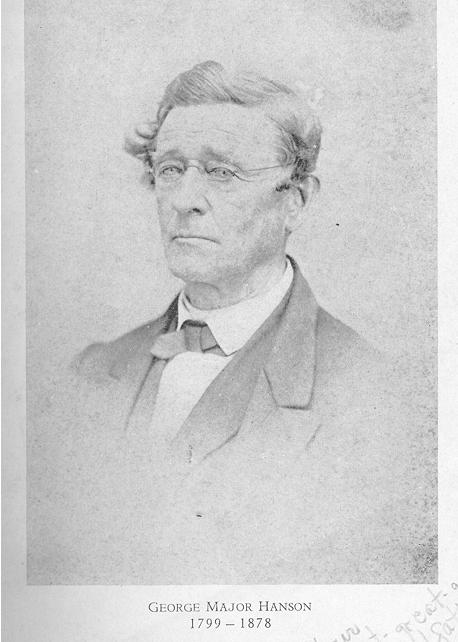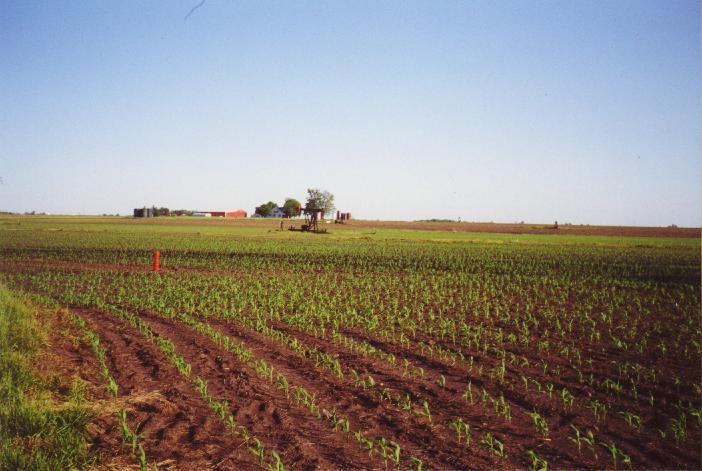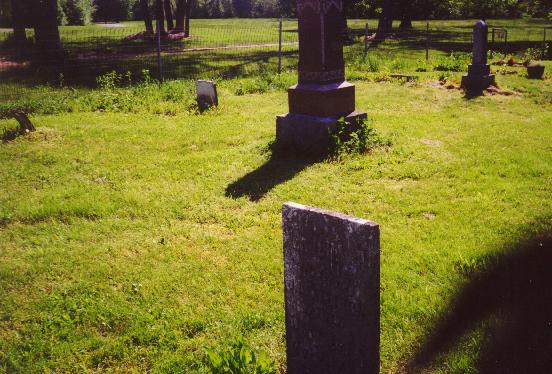This page follows the generations of the Hanson family, as I descend from them. The following links operate within this same page - click on the Hanson you want to see.
FIRST GENERATION: David Mark Hanson
SECOND GENERATION: George Major Hanson

George Major Hanson was born on March 13th, 1799, in Hansonville, Russell County, Virginia. He was one of eight children, four boys and four girls. George must have gotten some good training at home in his early years, judging by the path that his life took - he was by turns a postmaster, a state congressman, a state senator, and a federally appointed Indian agent.
On May 20th, 1819, George married Polly Ellington, and two years later they got started on their personal westward expansion. Prestonsburg, Kentucky was the first stop, where, according to Nicholas Hanson (grandson of G.M. Hanson and author of 'As I Remember', a privately published book of memories and some family history, published in 1944), George was a merchant. At the time Nicholas Hanson wrote his book, the structure which housed George's mercantile operation still stood, a 120 year old building. It may stand yet, though it seems unlikely. Five years after their Kentucky arrival, in 1826, the Hansons set out for the greener pastures of Illinois.
An interesting insight to George Hanson's motives is provided by Nicholas Hanson:
Grandfather never believed in slavery. He would never own slaves. That was the reason he left Virginia and went to Kentucky. Conditions were no better there and he went on to Illinois. Then he insisted that his brothers sell their slaves and property and locate in Illinois, a better country and a Free State. They would not do so.
When George Hanson got to Illinois, he settled at a place referred to as Wabash Point. It no longer exists as a community, but it can be located on a map near Lake Paradise in Coles County. In 1826, Coles County was still four years away from existing, and Illinois had only been admitted to the Union eight years previously. Today, the lands that George Hanson settled produce corn and wheat with little other purpose, but the landscape of 1826 was surely different, undisturbed forests waiting for the adventurous pioneer to settle. Further, the same adventurous pioneer would require a degree of bravery, as the Indians did not appreciate the usurpation of their land. The Black Hawk War pitted the white settlers against the Indians, and ended in 1832 - author Charles Wilson describes the war as "that last despairing struggle of the red man to retain a hold upon territory in Illinois". At its end, "the pioneers, at first somewhat in doubt whether they had not ventured too far into the wilds, now realized that their tenure of the land was secure". White settlement of Illinois grew more rapidly at that time, and George Hanson played a signicant role in the early days of Coles County. He was the original white owner of 760.1 acres (in 11 different parcels, not all contiguous) in Coles County, acquired between 1830 and 1837. He paid no more than $3.25 for any acre of land, and his average per acre was $1.55. Interestingly, some of his land in Pleasant Grove Township, Coles County, was no more than two and a half miles from Thomas Lincoln's (Abraham's father).
From the book "Historical Encyclopedia of Illinois (Edited by Newton Bateman and Paul Selby) and History of Coles County (edited by Charles Edward Wilson)", I excerpt the following relevant passage from Wilson's work:
George M. Hanson, a Methodist preacher, was a man of much public spirit, and displayed much energy and intelligence in his efforts in bahalf of the young community (Wabash Point). He drafted and, with Joseph Harvey and Andrew Caldwell, circulated the petition for the new county of Coles, and was made the bearer of the petition to the State Capital, the Vandalia. While there, with the assistance of Colonel William B. Archer, a member of the legislature from Clark County, he obtained the passage of the bill and returned home inside of two weeks, bringing with him a copy of the bill as passed. He also circulated a petition for, and obtained the establishment of the first postoffice in Coles County, which he named Paradise, and became its first postmaster. He was a member of the first Board of County Commissioners and later served in the Legislature, from 1842 to 1846 as Representative and 1846-48 as Senator. He was a preacher of much power and force and, in every sense, a leader.
George was appointed postmaster of Paradise, Illinois on February 18, 1830, and ran the operation out of his own house in Paradise township, where he held an 80 acre tract. Below is a picture of that land as it looks now:

This is the eastern portion of George Hanson's 80 acre tract in NE Paradise Township. It is typical of all the prairie plots he acquired originally, under cultivation now. To the west (right, on the picture) the Central Gulf Rail Road runs north-south through the plot.
George was elected a state Representative in the 13th General Assembly of Illinois (1842), the third of three members of that assembly from Coles County. He narrowly snuck into the third spot, beating fellow Whig Thomas Marshall by eight votes (591-583), and Whig Usher F. Linder (described by Wilson as "a man of considerable ability and one who, if he had possessed more stability of character, might have become a statesman...But he could not always be depended on, and had traits that injured his reputation as a citizen") by 35 votes. In the elections for the 14th General Assembly (1844), George ran for the same post - this time, Coles County had two Representatives, and George snuck in by three votes, 659-656 over Democrat Joseph Fowler. It must have been a sweet victory, as Fowler had been the leading vote-getter from 1842. In the fifteenth General Assembly (1846), George Hanson upped the stakes a little, and ran for a state senate seat, representing a district that included Clark, Coles, and Cumberland Counties. He won Coles easily, won Clark narrowly, and lost Cumberland, for a relatively easy win over Jerome Rowley, his only competitor.
George Hanson's wife Polly had died in 1845. They had ten children: Jerusha (m. John L. Allison), Elizabeth (m. Robert Colman Nabb), William Patton (M. Lydia Wilson), George Major (died unmarried around age 25), Nathan Ellington (did not marry), James Francis (m. Lillie Wilson), Daniel A. (m. Emily Margaret Morine), Rufus (killed in a fight with Indians in California as a young man), David Mark (m. Catherine O'Donnell), and Sidney (m. Daniel Linder, had five children, but died young). They also cared for niece Sidney Hanson as their own, according to Nicholas Hanson.
They named their children carefully, as five (George, Sidney, William, David, James) share names of George's siblings, one (David Mark) shares George Hanson's father's name. Nathan Ellington Hanson shared the name of Polly Ellington Hanson's father (She had a brother Nathan Ellington, too, who also emigrated from the hills of Russell County, Virginia, to Coles County, Illinois. He was first president of the village board of Charleston - seat of Coles - and first Clerk of Coles County Court, and his death by gunshot in 1855 by an upset son-in-law resulted in the offender becoming Charleston's first and only lynching victim). Rufus I assume was named because they ran out of other names and one of them had to be teased at school. George took a second wife, Jane Linder, and they had at least one child, who was named Polly.
George Hanson decided in 1849 that the time was right to head west again. Gold had been discovered in California, and according to Nicholas Hanson, this was George's motivation, and he set off with John Allender's west-bound train. He brought the whole family, including new wife and newborn, all seven sons, niece Sidney, daughter Sidney and her husband Daniel Linder, and the five Linder children. Daughter Jerusha had died in 1848 and daughter Elizabeth did not attend, although she, along with her family, would join four years later. Nicholas Hanson's account of this westward trek reads as follows:
"Grandfather chose the northern entrance to the Sacramento Valley. He left the Allender train and came through by the Lassen Trail with Peter Lassen as guide. After many trials and hardships in crossing the plains, he finally found it necessary to abandon his wagons in the Sierra wilderness and continue on foot with pack animals. After many more trials traveling on foot through the Sierra wilderness, they finally arrived in Yuba City in November, 1849, almost in destitute circumstances."
The scene that greeted the Hansons in California was no less than idyllic, if George's son David Mark Hanson's account of Lake County is to be believed to the letter. However, since he gives his account in a publication entitled "A Description of Lake County, California, Showing Its Advantages As A Place Of Residence", published by authority of the Lake County Board of Supervisors with a preface that states their intent to distribute it generally as an "inducement for settlers seeking desirable, healthful homes, to come among us", his account is probably to be taken with a grain of salt. Somewhere along the line he must have gotten the award for Best Written Sentence when he wrote, "While it is not our intention to doubt the great curative properties of our famous mineral springs, we believe that many cures are attributed to those waters, which, if the candid fact was known, might, to a considerable extent, have been attributable to our salubrious climate". David Hanson closes his article on the Lake County climate as follows: "That subtile and exhilirating property in our mountain air is not disclosed by the thermometer or foretold by barometrical observations. It must be experienced and enjoyed to be known. It is that "something" which has a rejuvenating effect an affords an effective panacea for physical depression".
Lake County wasn't quite heaven for George Hanson, though. In 1850, his second wife Jane died, and newborn Polly also died, a victim of drowning in the Feather River. Son Rufus died in California in an Indian battle. However, despite personal setbacks, and being fifty on his arrival in California, George did not just take it easy. He was publisher of the Sutter County Sentinel, Marysville Evening Telegraph, Daily Appeal, Clear Lake Sentinel, and Gilroy Advocate, by Nicholas Hanson's account. George was also appointed by one Abraham Lincoln, in April 1861, to be U.S. Indian Agent in California (California Indian Department, Northern Superintendency), at a salary of $4000.
Three letters written by George Major Hanson (two to brother James and one to brother William's widow) were transcribed by Evelyn Hanson Helton of Kingsport, Tennessee, who has shared them with me. Unfortunately the originals have apparently been burned. To view the text of these letters, click here.
I found two sources that are relevant to G.M. Hanson's story, and I have transcribed them in their entirety at the links below:
THIRD GENERATION: Jerusha Hanson
Jerusha Hanson followed her father's travels, at least to Illinois. In Coels County, Ilinois, on the 21st of March, 1843, J. B. Woollard united Jerusha and John L. Allison. John was the son of a physician and Methodist minister, so this union undoubtedly left both sets of parents happy (since Jerusha's father George was also a Methodist minister). Jerusha was not destined for long life, however, and died only 5 years later, on May 8th, 1848, reportedly due to complications arising from the birth of her first son, John Lewis Allison, Jr (she had previously had one daughter, Mary). At Jerusha's death, she was interred near her mother in the Campground Cemetery, on the banks of the Little Wabash in southwest Coles County (now the northeast part of Lake Paradise, since the Little Wabash has been dammed. This cemetery also has the nickname of 'God's Acre', due to the story behind its' inception - the woods by that part of the Little Wabash were used for early Methodist open-air gatherings, beginning in 1828, and continuing even after a permanent structure was built. Many tents were set up for the worship ceremonies, or camps (hence 'Campground'), and people began burying their dead on a plot cloe by, called God's Acre. Undoubtedly, Jerusha's father and father-in-law played important parts at these Methodist ceremonies. Across County Road 250E from the cemetery lies one of her father George Hanson's original plots of land, 40 acres acquired in 1832.

Jerusha Hanson Allison's final resting spot, in Campground Cemetery, Coles County, Illinois, located at the northeast corner of Paradise Lake. The whitish gravestone to the left of the larger monument marks her mother, Polly Ellington Hanson. Jerusha's inscription reads: "JERUSHA P. Wife Of J. L. ALLISON DIED May 8, 1848, aged 24 yrs 3 ms 17 ds" (though the age part is difficult to discern)
EMAIL:Jay Ingram
Back to Home Page
SOURCES
- Hanson, Nicholas W., As I Remember (Chico, California: Broyles and Camper, 1944).
- Pease, Thedore Calvin, ed., Illinois Election Returns 1818-1848 (Springfield, Ilinois: Illinois State Historical Library, 1923).
- A Description of Lake County, California, Showing Its Advantages as a place of residence. (Lakeport, California: Clear Lake Press, 1888). Published by authority of the Board of Supervisors, Lake County.
- Bateman, N., Selby, P., and Wilson, C. E., eds. Historical Encyclopedia of Illinois and History of Coles County (Chicago, Munsell Publishing Company, 1906).
- Basler, R.P., ed., The Collected Works of Abraham Lincoln (New Brunswick, N.J.: Rutgers University Press, 1953).
- Charleston and Mattoon Bicentennial Commissions, History of Coles County 1876-1976 (Dallas, Texas: Taylor Publishing Company).
- Cemeteries of Coles County, Illinois (Vol's I and III) (The Coles County Genealogical Society, 1994).
- Nichols, Ronald, Historical Plat Maps of Coles County, Illinois (The Coles County Genealogical Society, 1982).
- Illinois Public Domain Land Tract Sales, http://www.sos.state.il.us/depts/archives/data_lan.html
- Coles County Map & Tour Guide (Phelps Map Service, 1999).
PLEASE NOTE: I stopped updating the web page around 2001, but I've continued to work on my project. My family history is now in Word document format, with the goal of publishing it once I consider it to be as complete as I'm going to get it. While I'm greatly indebted to those who have assisted me in my research, I'm finding that the demands of everyday life don't allow me to consistently respond to email inquiries. So, I'm offering my most up-to-date volume for sale, at a price of $19. For those interested, it is at 118 pages right now, printed by a laser printer on 8.5x11 32-lb./98 brightness paper, and wire bound. The table of contents, revision history, and index are available at the following links. To order a copy, please email me at [email protected], and I'll send it within 3 days of payment. If you indicate the family line you are interested in, I'll send you a new bound copy if and when I update my research for that line. Thanks,
Jay
This page hosted by  �
Get your own Free Home Page
�
Get your own Free Home Page


![]() �
Get your own Free Home Page
�
Get your own Free Home Page